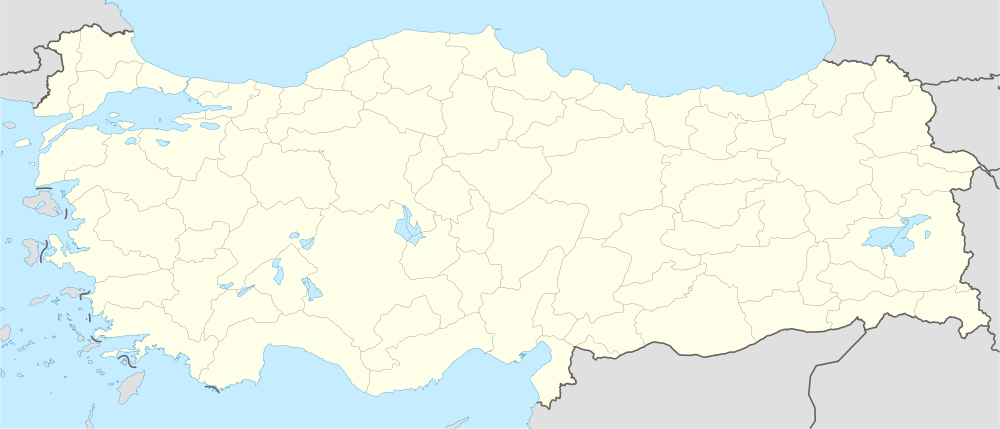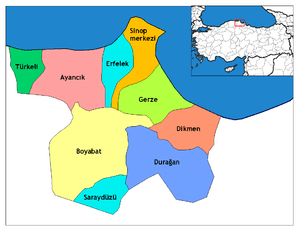Sinop, Turkey
| Sinop | |
|---|---|
| Municipality | |
|
A collage of Sinop, Turkey. Top left: view of Sinop North Wall, nearby Demirci and Bezirci area; top right: Sinop Fortress and Port of Sinop; middle right: View of Plaj Yolu, nearby Sinop Anadolu Imam Hatip College from Baris Manco Park; bottom left: Panorama view of downtown Sinop, from Hippodrome Hill; bottom right: Hamsilos resort area | |
 Sinop Location of Sinop, Turkey | |
| Coordinates: 42°02′N 35°09′E / 42.033°N 35.150°ECoordinates: 42°02′N 35°09′E / 42.033°N 35.150°E | |
| Country |
|
| Region | Black Sea |
| Province | Sinop |
| Districts | 9 |
| Government | |
| • Mayor | Baki Ergül (Republican People's Party, CHP) |
| • Governor | Ahmet Cengiz |
| Area[1] | |
| • District | 438.58 km2 (169.34 sq mi) |
| Population (2012)[2] | |
| • Urban | 38,571 |
| • District | 57,399 |
| • District density | 130/km2 (340/sq mi) |
| Time zone | EET (UTC+2) |
| • Summer (DST) | EEST (UTC+3) |
| Postal code | 57xxx |
| Area code(s) | (+90) 368 |
| Licence plate | 57 |
| Climate | Cfb |
| Website | www.sinop.bel.tr |
Sinop (Greek: Σινώπη, Sinōpē) is a city with a population of 36,734 on İnce Burun (İnceburun, Cape Ince), by its Cape Sinop (Sinop Burnu, Boztepe Cape, Boztepe Burnu) which is situated on the most northern edge of the Turkish side of the Black Sea coast, in the ancient region of Paphlagonia, in modern-day northern Turkey, historically known as Sinope /sɨˈnoʊpi/. It is the capital of Sinop Province.
History
Long used as a Hittite port, which appears in Hittite sources as "Sinuwa",[3] the city proper was re-founded as a Greek colony from the city of Miletus in the 7th century BC.[4] Sinope flourished as the Black Sea port of a caravan route that led from the upper Euphrates valley.[5] It issued its own coinage, founded colonies, and gave its name to a red earth pigment called sinopia, which was mined in Cappadocia for use throughout the ancient world.[6]
Sinope escaped Persian domination until the early 4th century BC. It was ruled by Scydrothemis from 301 to 280 BC. In 183 BC it was captured by Pharnaces I and became capital of the Kingdom of Pontus. The Roman general Lucullus conquered Sinope in 70 BC, and Julius Caesar established a Roman colony there, Colonia Julia Felix, in 47 BC. Mithradates Eupator was born and buried at Sinope, and it was the birthplace of Diogenes, of Diphilus, poet and actor of the New Attic comedy, of the historian Baton, and of the Christian heretic of the 2nd century AD, Marcion.
After the division of the Roman Empire in 395, Sinope remained with the Eastern Roman or Byzantine Empire. Its history in the early Byzantine period is obscure, except for isolated events: it was used by Justinian II as a base from which to reconnoitre Cherson, participated in the rebellion of the Armeniac Theme in 793, was the site of Theophobos' proclamation as emperor by his Khurramite troops in 838, and suffered its only attack by the Arabs in 858.[7]
In 1081, the city was captured by the Seljuk Turks, who found there a sizeable treasury, but Sinope was soon recovered by Alexios I Komnenos, ushering a period of prosperity under the Komnenian dynasty.[7] After the sacking of Constantinople by the Fourth Crusade in 1204, it was captured for the Empire of Trebizond by David Komnenos, until the Seljuk Turks of Rûm successfully captured the city in 1214.[7][8] The city returned briefly to Trapezuntine rule in ca. 1254, but returned to Turkish control in 1265, where it has remained since.[7]
After 1265, Sinop became home to two successive independent emirates following the fall of the Seljuks: the Pervâne and the Jandarids. The Ottoman Sultan Mehmet II overawed Ismail, the emir of Sinope on his march on Trebizond, and forced him to surrender the city to the Sultan late June 1461 without a fight. The emir was exiled to Philippopolis (modern Plovdiv) in northern Thrace.[9]
In November 1853, at the start of the Crimean War, in the Battle of Sinop, the Russians, under the command of Admiral Nakhimov, destroyed an Ottoman frigate squadron in Sinop, leading Britain and France to declare war on Russia.
In the late 19th and early 20th century, Sinop was part of the Kastamonu Vilayet of the Ottoman Empire.
As of 1920, Sinop was described as populated mainly by Greeks with an approximate population of 8,000. It was also considered the "safest" port "between Bosphorus and Batum," at the time. During this period, the port was exporting wheat, tobacco, seeds, timber and hides. They imported produce, coal and hardware.[10]
Sinop hosted a US military base that was important for intelligence during the cold war era. The US base was closed in 1992.
Explorer Bob Ballard discovered an ancient ship wreck north west of Sinop in the Black Sea and was shown on National Geographic.
Historic sites
Notable historical places are:[11][12]
- Sinop Fortress
- Sinop Fortress Prison
- Balatlar Church
- Temple of Serapis
- Pasha Bastion
- Pervane Medrese
- Alaaddin Mosque
-

Sinop old city, Ottoman era postcard
-
Black Sea and Sinop port.
-
Sinop museum
Climate
Sinop has an oceanic climate (Köppen: Cfb).
Sinop has warm and humid summers with an average daytime high of 26 °C (78.8 °F) however temperatures rarely exceed 30 °C (86 °F). The highest recorded temperature for Sinop was 34.4 °C (93.92 °F) on 6 July 2000. The winters are cool and wet. The average for winter ranging around 5 °C (41 °F). The lowest recorded temperature for Sinop was -7.5 °C (18.5 °F) on 21 February 1985. Snowfall is quite common between the months of December and March, snowing for a week or two.
| Climate data for Sinop | |||||||||||||
|---|---|---|---|---|---|---|---|---|---|---|---|---|---|
| Month | Jan | Feb | Mar | Apr | May | Jun | Jul | Aug | Sep | Oct | Nov | Dec | Year |
| Average high °C (°F) | 9.7 (49.5) |
9.6 (49.3) |
10.5 (50.9) |
14.1 (57.4) |
18.3 (64.9) |
23.0 (73.4) |
25.8 (78.4) |
26.2 (79.2) |
23.0 (73.4) |
19.2 (66.6) |
15.5 (59.9) |
12.1 (53.8) |
17.25 (63.06) |
| Daily mean °C (°F) | 6.9 (44.4) |
6.6 (43.9) |
7.5 (45.5) |
10.7 (51.3) |
15.0 (59) |
19.8 (67.6) |
22.8 (73) |
23.1 (73.6) |
19.9 (67.8) |
16.2 (61.2) |
12.5 (54.5) |
9.2 (48.6) |
14.18 (57.53) |
| Average low °C (°F) | 4.6 (40.3) |
4.2 (39.6) |
5.1 (41.2) |
8.1 (46.6) |
12.3 (54.1) |
16.9 (62.4) |
19.9 (67.8) |
20.3 (68.5) |
17.3 (63.1) |
13.7 (56.7) |
9.9 (49.8) |
6.9 (44.4) |
11.6 (52.88) |
| Average precipitation mm (inches) | 73.6 (2.898) |
50.3 (1.98) |
49.7 (1.957) |
38.6 (1.52) |
33.5 (1.319) |
34.2 (1.346) |
33.8 (1.331) |
41.8 (1.646) |
66.7 (2.626) |
86.5 (3.406) |
85.6 (3.37) |
87.2 (3.433) |
681.5 (26.832) |
| Avg. rainy days | 15.5 | 13.4 | 13.3 | 11.6 | 10.3 | 8.2 | 5.5 | 6.3 | 9.1 | 12.2 | 13.1 | 15.8 | 134.3 |
| Average relative humidity (%) | 68 | 68 | 73 | 75 | 76 | 74 | 74 | 67 | 71 | 71 | 68 | 68 | 71.1 |
| Mean monthly sunshine hours | 71.3 | 86.8 | 127.1 | 153 | 207.7 | 264 | 291.4 | 263.5 | 207 | 145.7 | 96 | 68.2 | 1,981.7 |
| Source #1: Sinop Turkish State Meteorological Service | |||||||||||||
| Source #2: Weatherbase [13] | |||||||||||||
Economy
As of 1920, Sinop was producing embroidered cotton cloth. They also were known for boatbuilding. The British described the boats produced in Sinop as being of "primitive design but sound workmanship."[14]
Notable people
- Historical
- Aquila of Sinope (2nd century), Bible translator
- Diogenes of Sinope (412 or 404 BC–323 BC), philosopher
- Mithridates VI of Pontus (134 BC–63 BC), king of Pontus
- Gazi Chelebi (14th century), naval commander
- Saint Helen of Sinope (18th century)
- Marcion of Sinope (ca. 85–160), heretic
- İsfendiyar Bey of the Candar beylik
- Seydi Ali Reis, Ottoman admiral, writer and scientist, was born into a family who was originally from Sinop.
- Contemporary
- Rıza Nur (1879–1942), politician
- Ahmet Muhip Dıranas (1909–1980), poet
- Necmettin Erbakan (1926–2011), former prime minister
- Patriarch Maximus V of Constantinople (1897–1972), Ecumenical Patriarch of Constantinople
- Osman Pamukoğlu (1947–), politician
- Metin Tuğlu (1984–), footballer
- Hakan Ünsal (1973–), footballer
- Sinan Uzun (1990–), footballer
Miscellaneous
Sinope has given its name to the outermost satellite of Jupiter. A crater on Mars is named after Sinop.
Sister cities
Sinop has 10 sister cities:
-
 Bogotá, [Colombia
Bogotá, [Colombia -
 Çorlu, Turkey
Çorlu, Turkey -
 Riffa, Bahrain
Riffa, Bahrain -
 Izki, Oman
Izki, Oman -
 Järve, Estonia]
Järve, Estonia] -
 Lyon, France
Lyon, France -
 Mosjøen, Norway
Mosjøen, Norway -
 Murmansk, Russia
Murmansk, Russia -
 Swansea, Wales, United Kingdom
Swansea, Wales, United Kingdom -
 Varna, Bulgaria
Varna, Bulgaria
See also
References
- ↑ "Area of regions (including lakes), km²". Regional Statistics Database. Turkish Statistical Institute. 2002. Retrieved 2013-03-05.
- ↑ "Population of province/district centers and towns/villages by districts - 2012". Address Based Population Registration System (ABPRS) Database. Turkish Statistical Institute. Retrieved 2013-02-27.
- ↑ J. Garstang, The Hittite Empire, p. 74
- ↑ Xenophon, Anabasis 6.1.15; Diodorus Siculus 14.31.2; Strabo 12.545
- ↑ Herodotus 1.72; 2.34
- ↑ Thompson, Daniel V. (1956). The Materials and Techniques of Medieval Painting. New York: Dover Publications. ISBN 0-486-20327-1.
- ↑ 7.0 7.1 7.2 7.3 Foss, Clive (1991). "Sinope". In Kazhdan, Alexander. The Oxford Dictionary of Byzantium. Oxford and New York: Oxford University Press. p. 1904. ISBN 978-0-19-504652-6.
- ↑ Vasiliev, V. V. (1936). "The Foundation of the Empire of Trebizond (1204-1222)". Speculum 11. pp. 26–29. JSTOR 2846872.
- ↑ Runciman, Steven (1969). The Fall of Constantinople. London: Cambridge. p. 174.
- ↑ Prothero, G. W. (1920). Anatolia. London: H.M. Stationery Office.
- ↑ "Sinop". karalahana.com.
- ↑ "About Sinop". karalahana.com.
- ↑ http://www.weatherbase.com/weather/weatherall.php3?s=62071&refer=&units=us&cityname=Sinop-Turkey
- ↑ Prothero, G. W. (1920). Anatolia. London: H.M. Stationery Office. p. 112.
- John Garstang, The Hittite Empire (University Press, Edinburgh, 1930).
- turkey travel guide, tourist spot in sinop (Turista Travel, since 2001).



